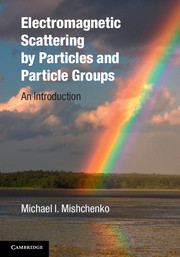Book contents
- Frontmatter
- Dedication
- Contents
- Preface
- Acknowledgments
- Acronyms
- 1 Introduction
- 2 The macroscopic Maxwell equations and monochromatic fields
- 3 Fundamental homogeneous-medium solutions of the macroscopic Maxwell equations
- 4 Basic theory of frequency-domain electromagnetic scattering by a fixed finite object
- 5 Far-field scattering
- 6 The Foldy equations
- 7 The Stokes parameters
- 8 Poynting–Stokes tensor
- 9 Polychromatic electromagnetic fields
- 10 Polychromatic scattering by fixed and randomly changing objects
- 11 Measurement of electromagnetic energy flow
- 12 Measurement of the Stokes parameters
- 13 Description of far-field scattering in terms of actual optical observables
- 14 Electromagnetic scattering by a small random group of sparsely distributed particles
- 15 Statistically isotropic and mirror-symmetric random particles
- 16 Numerical computations and laboratory measurements of electromagnetic scattering
- 17 Far-field observables: qualitative and quantitative traits
- 18 Electromagnetic scattering by discrete random media: far field
- 19 Near-field scattering by a sparse discrete random medium: microphysical radiative transfer theory
- 20 Radiative transfer in plane-parallel particulate media
- 21 Weak localization
- 22 Epilogue
- Appendix A Dyads and dyadics
- Appendix B Free-space dyadic Green's function
- Appendix C Euler rotation angles
- Appendix D Spherical-wave decomposition of a plane wave in the far zone
- Appendix E Integration quadrature formulas
- Appendix F Wigner d-functions
- Appendix G Stationary phase evaluation of a double integral
- Appendix H Hints and answers to selected problems
- References
- Index
- Plate Section
21 - Weak localization
Published online by Cambridge University Press: 05 July 2014
- Frontmatter
- Dedication
- Contents
- Preface
- Acknowledgments
- Acronyms
- 1 Introduction
- 2 The macroscopic Maxwell equations and monochromatic fields
- 3 Fundamental homogeneous-medium solutions of the macroscopic Maxwell equations
- 4 Basic theory of frequency-domain electromagnetic scattering by a fixed finite object
- 5 Far-field scattering
- 6 The Foldy equations
- 7 The Stokes parameters
- 8 Poynting–Stokes tensor
- 9 Polychromatic electromagnetic fields
- 10 Polychromatic scattering by fixed and randomly changing objects
- 11 Measurement of electromagnetic energy flow
- 12 Measurement of the Stokes parameters
- 13 Description of far-field scattering in terms of actual optical observables
- 14 Electromagnetic scattering by a small random group of sparsely distributed particles
- 15 Statistically isotropic and mirror-symmetric random particles
- 16 Numerical computations and laboratory measurements of electromagnetic scattering
- 17 Far-field observables: qualitative and quantitative traits
- 18 Electromagnetic scattering by discrete random media: far field
- 19 Near-field scattering by a sparse discrete random medium: microphysical radiative transfer theory
- 20 Radiative transfer in plane-parallel particulate media
- 21 Weak localization
- 22 Epilogue
- Appendix A Dyads and dyadics
- Appendix B Free-space dyadic Green's function
- Appendix C Euler rotation angles
- Appendix D Spherical-wave decomposition of a plane wave in the far zone
- Appendix E Integration quadrature formulas
- Appendix F Wigner d-functions
- Appendix G Stationary phase evaluation of a double integral
- Appendix H Hints and answers to selected problems
- References
- Index
- Plate Section
Summary
The main advantage of the microphysical approach to radiative transfer is that it establishes a direct link between the MMEs and the RTE via a sequence of nine unambiguously defined and physically realizable assumptions and approximations summarized in Section 19.13. By keeping assumptions 1, 2, and 4–8 from Section 19.13, but relaxing approximations 3 and 9, one can extend the micro-physical approach and establish a similar direct link between the MMEs and the effect of WL of electromagnetic waves by a sparse DRM. Specifically, one can supplement the computation of the ladder component of the dyadic correlation function with the computation of the so-called “cyclical” component. The latter is caused by pairs of multi-particle sequences exemplified by Plates 18.1e and 18.1h. As we have seen in Section 18.4, the sum of the ladder and cyclical components can be expected to provide a better representation of optical observables at certain points located in the far zone of the particulate medium.
It is important to recognize that WL is not an independent physical phenomenon. It is implicitly contained in the exact solution of the MMEs (Section 18.4) but “falls through the cracks” when one resorts to the ladder approximation in order to simplify the computation. Therefore, one may characterize WL as the difference between the exact solution of the MMEs for a sparse DRM and the ladder approximation, although this characterization may still not be fully accurate since it neglects the existence of multi-particle sequences that go through a particle more than once.
Information
- Type
- Chapter
- Information
- Electromagnetic Scattering by Particles and Particle GroupsAn Introduction, pp. 357 - 367Publisher: Cambridge University PressPrint publication year: 2014
